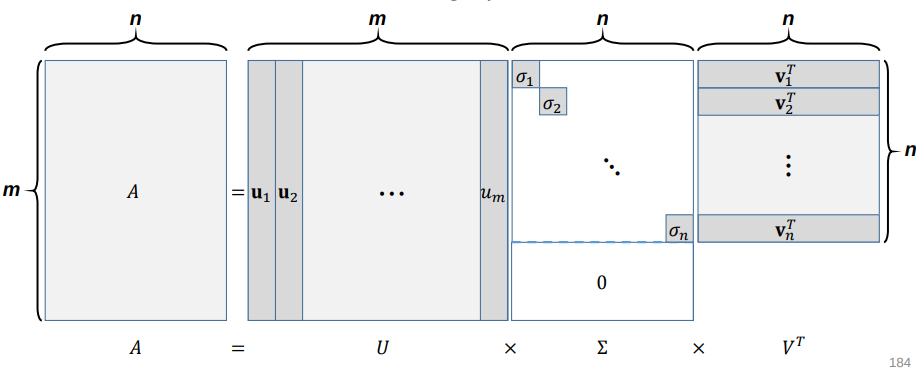Singular Value Decomposition (SVD)
@(LinearAlgebra)
SVD
Given a rectangular matrix , its singular value decomposition is written as
where
- , : matrices with orthonormal columns, providing an orthonormal basis of Col and Row , respectively.
- : a diagonal matrix whose entries are in a decreasing order, i.e.,
Basic Form of SVD
Given a rectangular matrix where , SVD gives

SVD as Sum of Rand 1 Outer Products
can also be represented as the sum of outer products

Reduced Form of SVD
can also be represented as the sum of outer products

Another Perspective of SVD
- We can easily find two orthonormal basis sets, for Col and for Row , by using, say, Gram–Schmidt orthogonalization.
- Are these unique orthonormal basis sets?
No. Then, can we jointly find them such that
Let us denote , , and
- Consider and
- since has orthonormal columns.
- Thus, .
Computing SVD
- First, we form and and compute eigendecomposition of each:
- Can we find the following?
- Orthogonal eigenvector matrices and
- Eigenvalues in that are all positive
- Eigenvalues in that are shared by and
- Yes, since and are symmetric positive (semi-)definite.
Symmetric Positive Definite Matrices and Spectral Decomposition
• If is symmetric and positive-definite, then the spectral decomposition will have all positive eigvenvalues:
where .
and are symmetric positive (semi-)definite!
Symmetric:
Positive (semi-)definite
Thus, we can find
- Orthogonal eigenvector matrices and .
- Eigenvalues in that are all positive
Things to Note
- Given any rectangular matrix , its SVD always exists.
- Given a square matrix , its eigendecomposition does not always exist, but its SVD always exists.
- Given a square, symmetric positive (semi-)definite matrix , its eigendecomposition always exists, and it is actually the same as its SVD.